The aim of this competition is for a Handler to direct his dog around a course of different obstacles to assess and enhance the ability of the dog and Handler to work as a team. It is an educational and sporting activity intended to improve the dog's integration into society. The sport requires a good rapport between dog and Handler, which results in perfect teamwork. Whilst speed of the dog is to be desired, steadiness of work is essential to a faultless performance of the course.
Entry Requirements
All dogs are placed in classes depending on their height at the withers.
|
Class |
Dogs Height |
|
200 |
Up to and including 270 mm |
|
300 |
271 mm up to and including 365 mm |
|
400 |
366 mm up to and including 455 mm |
|
500 |
456 mm up to and including 545 mm |
|
600 |
546 mm and over |
Bitches in season cannot enter.
The only items that a dog can wear whilst running the course are:
- A fixed, flat collar with no fixtures or tags etc. dangling from the collar, with the exception of D or O rings which form part of the collar
- Ribbons or bands to keep the hair away from the face.
Obstacles
All contact equipment shall have an effective all-weather non-slip surface– these include Scramble, Dog Walk and Seesaw.
Broad Jump
The Broad Jump consists of two (2) to four (4) separate boards. All boards of the broad jump must be the same colour.
Each board is to have length of between 1200 mm and 1500 mm and be of a height and width as described in the table below. For convenience the four (4) boards may be built to telescope. There must be four (4) corner posts, which are to be a minimum of 1200 mm high and have a diameter of 20 mm.
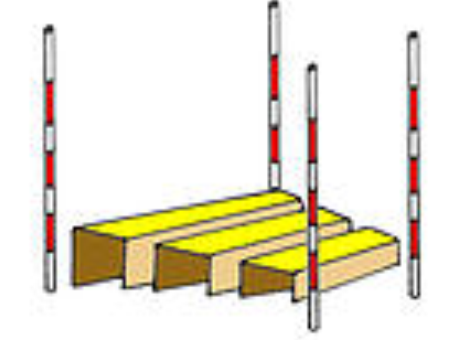
The distance that a dog must jump and the number of boards to be used in the Broad Jump will be as follows:
|
Height Category |
Jump Distance |
Number of Boards |
Board Heights |
Width of Boards |
|
200 |
400mm |
2 |
100 & 150mm |
100-150mm |
|
300 |
600mm |
2 |
100 & 150mm |
100-150mm |
|
400 |
800mm |
3 |
100, 150 & 200mm |
150-200mm |
|
500 |
1000mm |
4 |
100, 150, 200 & 250mm |
150-200mm |
|
600 |
1200mm |
4 |
100, 150, 200 & 250mm |
150-200mm |
Dog Walk
The Dog Walk consists of three (3) connected planks; one plank angled up from the ground to the end of an elevated horizontal plank and the other angled from the other end, down to the ground and must be a light and visible colour i.e. white or a pale colour. This obstacle must not have cleats fitted to the planks.
The length of each plank shall be 3500 mm. The width shall be a minimum of 300 mm to a maximum of 330 mm. The horizontal plank is to be set 1200 mm off the ground. From the grounded end of the planks, there will be a contact area of 1100 mm a different colour to the remainder of the obstacle. This contact area is to be coloured on all visible sides.

Hoop
The Hoop shall have an inside diameter of 600 mm and a minimum fascia depth of 75 mm and thickness of 75 mm, the base of which must be secured to the ground. All hoops must be of a breakaway design which does not impede the dog’s progress when broken away. Any base supports used on the side must be a maximum of 300mm and no higher than 30mm.
The height of the Hoop from the inside rim to the ground is to be adjustable for each height category. The inside of the Hoop must be closed as a safety measure and padded if it is of a solid material.
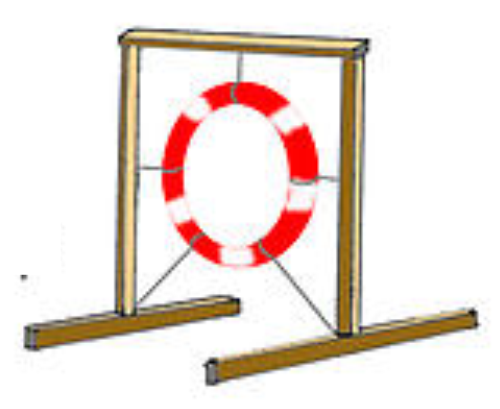
Hurdles
Hurdles consist of two (2) uprights, which support a bar or other centre section. The base support projection from the side of the jump must be a maximum length of 300 mm.
Hurdles are to be adjustable for each height category. The uprights, which may be winged, are to be a minimum of 1000 mm high. The distance between the uprights is to be between 1200 mm and 1500 mm. Bars are to be made of any material that is unlikely to injure if they are displaced. The bar is to be a minimum of 30 mm in diameter and be in contrasting colours in alternate sections. Nails or spikes are not to be used to support the bars All centre sections of Hurdles, whether bar or other, must be able to be dislodged if hit hard enough in EITHER direction.
Jump cups are not to have sharp edges.
The other centre sections may consist of fill-in bars, crossed bars or a solid section of any construction e.g. brush fence, solid wall, pseudo brick wall etc. but must be able to be dislodged. The total width of the wing including the upright to be a maximum of 600mm.
The Hurdles must be adjustable for each height category as shown below.
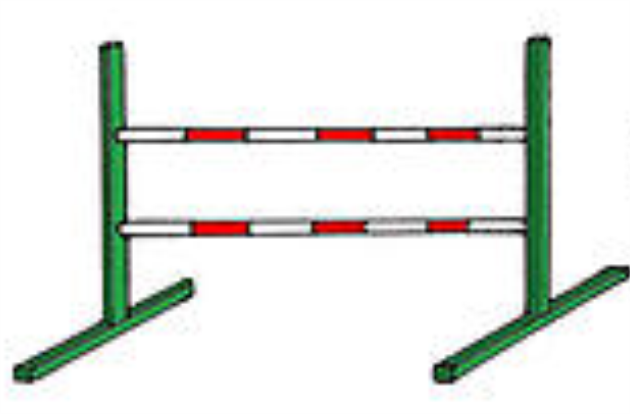
Spread Hurdle
A Spread Hurdle consists of two (2) bar Hurdles. The base support projection from the side of the jump must be a maximum length of 300 mm.
|
Height Category |
Distance Between Hurdles |
Height of First Bar to the Ground |
Height of Second Bar to the Ground |
|
200 |
150 mm |
150 mm |
200 mm |
|
300 |
225 mm |
225 mm |
300 mm |
|
400 |
300 mm |
300 mm |
400 mm |
|
500 |
375 mm |
375 mm |
500 mm |
|
600 |
450 mm |
450 mm |
600 mm |
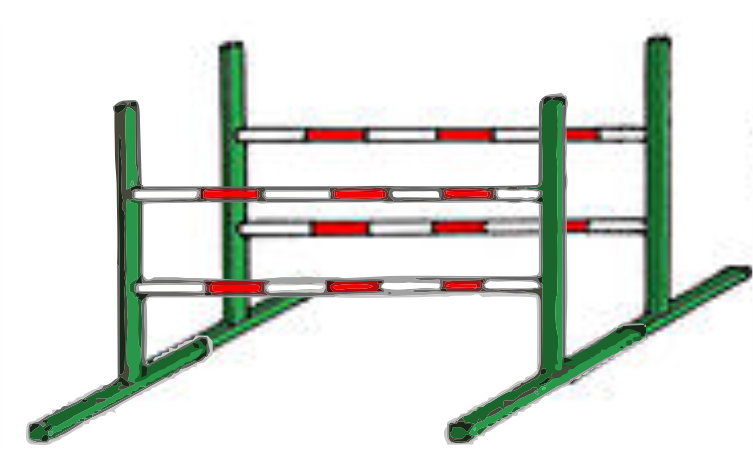
Scramble
The Scramble consists of two (2) planks connected at the top in an "A" form.
The length of each plank is to be 2400 mm and the minimum width is to be 900 mm. Existing 2500 mm planks are acceptable providing the angle at the apex is the same as a 2400 mm plank. All Scrambles made after 1st July 2006 are to be made in accordance with the 2400 mm standard.
The length of the obstacle along the ground to form the base of the "A" is to be 3850 mm for planks of 2500 mm and 3700 mm for planks of 2400 mm length.
From the grounded end of the planks, there will be a contact area of 1100 mm a different colour to the remainder of the obstacle. This contact area is to be coloured on all visible sides.
The planks are to have five (5) half round cleats that have a height of 6 mm and a width of 15 mm set approximately 200 mm apart starting from the apex.
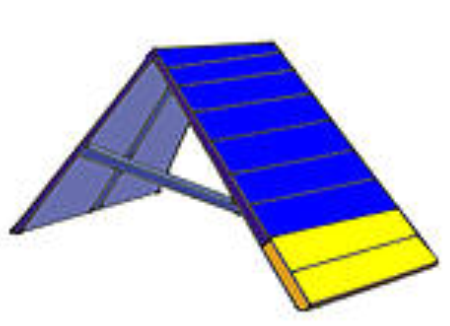
Seesaw
A Seesaw is a plank poised on a near central bracket.
The length of the plank should be 3500 mm. The width is to be a minimum of 300 mm to a maximum of 330 mm. The height of the up end of the plank will be 900mm.
The Seesaw will have a drop rate of minimum of 2 seconds to a maximum of 3 seconds. This is determined by placing a 1kg weight at 150 mm from the up end of the Seesaw and recording the time to hit the ground.
Contact areas 1100 mm from both ends of the plank are to be visible on all sides and will be a different colour to the remainder of the obstacle. The obstacle must be stable. The plank is to be designed to return to the original position once the dog has alighted.
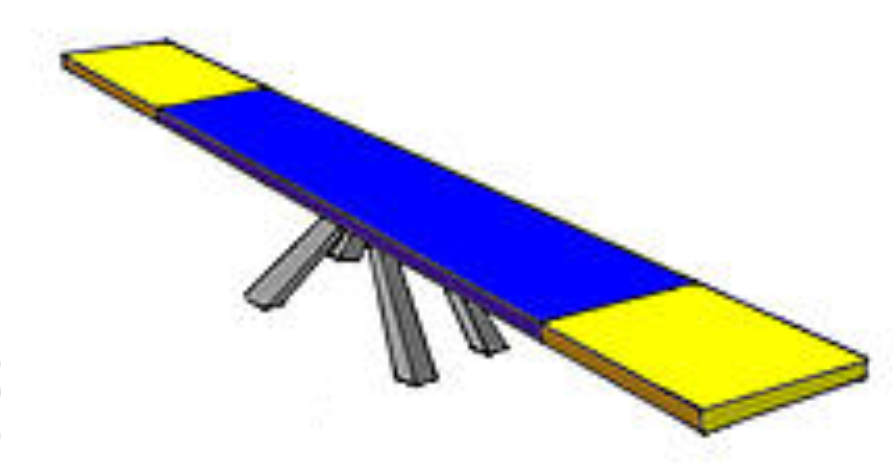
Flexible Tunnel
The Flexible Tunnel is an open opaque flexible concertina type tube. It is to measure approximately 600 mm inside diameter and be a minimum of four (4) metres to a maximum of eight (8) metres long. The tunnel is to be flexible so that one or more bends can be shaped. It must be secured so that it will not move whilst in use.
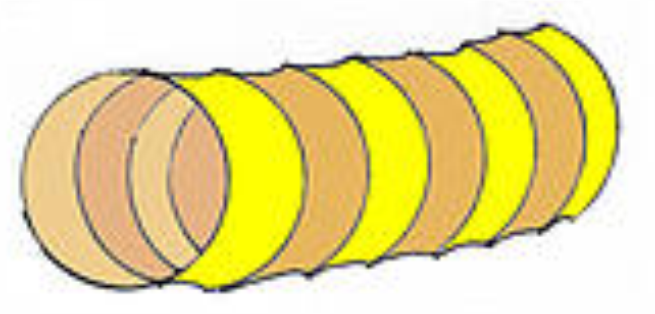
Weaving Poles
There will be twelve (12) Weaving Poles for all classes that have Weaving Poles. The poles are to be set vertically in a straight line 600 mm apart (centre to centre) without any 10% variation. They are to be a minimum of 1000 mm to a maximum of 1200 mm in height and a minimum of 20 mm to a maximum of 30 mm in diameter. No bar is to be fixed along the top of the poles. The Weaving Poles must be made of a lightweight and flexible material, e.g. similar to PVC, allowing the dog to flex the poles as it is weaving. The base of the pole may be rigid to a maximum height from the ground of 200 mm.
The Weaving Poles will have a flat metal bar along the centre with metal legs extending laterally; the legs and bar must be fixed and secured, where possible, with a non-slip surface. The legs must be offset to the dog's path. Pegs to be fitted into holes drilled into metal base. No pegs are allowed in the dog's path.
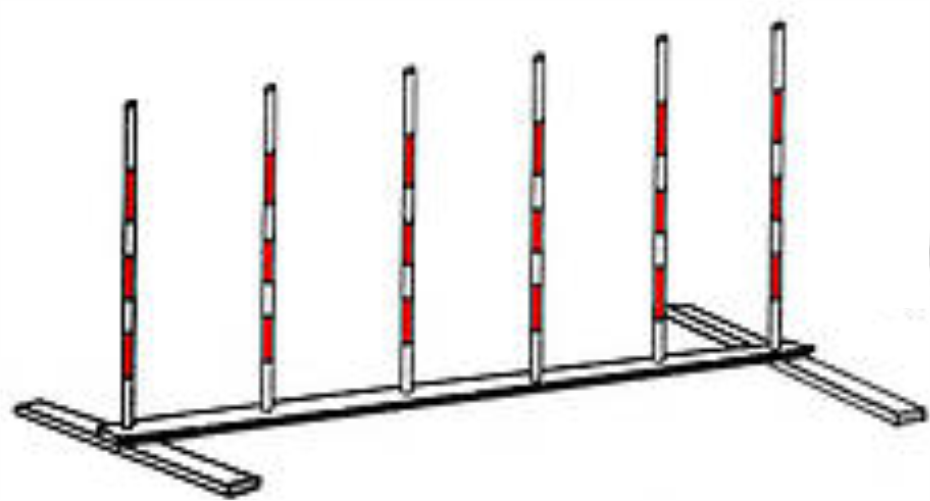
NOVICE AGILITY CLASS (14-16 OBSTACLES)
There is no limit to the number of times an obstacle can be used, with the exception of the contact obstacles, Spread Hurdle, and Weaving Poles, which are not to be negotiated more than once.
Mandatory Obstacles
|
Ø Broad Jump/s Ø Dog Walk Ø Hoop/s Ø Hurdle/s |
Ø Spread Hurdle Ø Scramble Ø Flexible Tunnel/s Ø Weaving Poles - 12 |
EXCELLENT AGILITY CLASS (16-20 OBSTACLES)
There is no limit to the number of times an obstacle can be used, with the exception of the contact obstacles and Weaving Poles, which are not to be negotiated more than once.
Mandatory Obstacles
|
Ø Broad Jump/s Ø Dog Walk Ø Hoop/s Ø Hurdle/s Ø Spread Hurdle |
Ø Scramble Ø Seesaw Ø Flexible Tunnel/s Ø Weaving Poles-12 |
MASTER AGILITY CLASS (20-24 OBSTACLES)
With the exception of those obstacles marked "optional", all obstacles listed below must be performed. The Weaving Poles can only be negotiated once.
Mandatory Obstacles
|
Ø Broad Jump/s Ø Dog Walk/s Ø Hoop/s Ø Hurdle/s Ø Spread Hurdle/s |
Ø Scramble/s Ø Seesaw/s Ø Flexible Tunnel/s Ø Weaving Poles-12 |
OPEN AGILITY CLASS (16-20 OBSTACLES)
There is no limit to the number of times an obstacle can be used, with the exception of the contact obstacles and Weaving Poles, which are not to be negotiated more than once.
Mandatory Obstacles
|
Ø Dog Walk Ø Hurdle/s Ø Scramble |
Ø Seesaw Ø Flexible Tunnel/s Ø Weaving Poles- 12 |
NOVICE JUMPING CLASS (14-16 OBSTACLES)
There is no limit to the number of times an obstacle can be re-negotiated in the Novice Jumping class with the exception of the Spread Hurdle, which can only be negotiated once.
Mandatory Obstacles
|
Ø Broad Jump/s Ø Hoop/s Ø Flexible Tunnel/s |
Ø Hurdle/s Ø Spread Hurdle |
EXCELLENT JUMPING CLASS (16-20 OBSTACLES)
There is no limit to the number of times an obstacle can be re-negotiated in the Excellent Class.
Mandatory Obstacles
|
Ø Broad Jump/s Ø Hoop/s Ø Flexible Tunnel/s |
Ø Hurdle/s Ø Spread Hurdle/s |
MASTER JUMPING CLASS (20-24 OBSTACLES)
There is no limit to the number of times an obstacle can be re-negotiated in the Master Class.
Mandatory Obstacles
|
Ø Broad Jump/s Ø Hoop/s |
Ø Flexible Tunnel/s Ø Hurdle/s Ø Spread Hurdle/s |
OPEN JUMPING CLASS (16-20 OBSTACLES)
There is no limit to the number of times an obstacle can be re-negotiated in the Open Jumping Class. The Judge may select obstacles from the following list to use in the course.
Mandatory Obstacles
|
Ø Broad Jump/s Ø Hoop/s Ø Hurdle/s |
Ø Spread Hurdle/s Ø Flexible Tunnel/s |
Agility and Jumping Scoring and Titles
All dogs eligible to be entered in Agility Trials in accordance with these rules shall be eligible to receive Title Certificates upon qualification and subsequent application.
The Canine Control will receive application for the use of the relevant title letters after the name of each dog, when the dog has gained a qualification certificate at the following specified number of Trials under the specified number of Judges.
|
CLASS |
NOVICE |
EXCELLENT |
MASTER |
OPEN |
|
TITLE |
AD/JD |
ADX/JDX |
ADM/JDM |
ADO/JDO |
|
Number of Certificates |
5 |
6 |
7 |
5 |
|
Number of Judges |
3 |
3 |
3 |
3 |
Agility Champion
A dog will be eligible for the title of Agility Champion 200, 300, 400, 500, 600 when they have attained 1000 points, these can only be gathered at the completion of the Masters title in each category of which 100 points from Agility and 100 points from Jumping must be after 1st July 2011.
Agility – after completion of their ADM title – earn 500 points.
Points are awarded as follows:
- 1st Place Qualifying score = 25 points
- 2nd Place Qualifying score = 20 points
- 3rd Place Qualifying score = 15 points
- Qualifying score only = 10 points
Jumping - after completion of their JDM title – earn 500 points.
Points are awarded as follows:
- 1st Place Qualifying score = 25 points
- 2nd Place Qualifying score = 20 points
- 3rd Place Qualifying score = 15 points
- Qualifying score only = 10 points
Scoring
To obtain a CLEAR ROUND a dog must negotiate the course within the SCT and not incur any faults as defined by these Rules.
Any dog obtaining a clear round shall receive a Qualifying Certificate signed by the Judge.
Faults
Course Faults
Five (5) faults, (i.e. one Course Fault), are scored for each mistake a dog makes.
Time Faults
The time taken to complete the course will be measured and recorded up to 1/100 second. Time faults are scored as actual time over the SCT i.e. 3.38 seconds over the SCT scores 3.38 time faults.
Penalty Faults
Penalty Faults are those faults e.g. (disciplinary) incurred by the dog or Handler in addition to any time or course faults.
Total faults
A dog's total faults are the sum of the course faults, time faults and penalty faults.
Placings
When working out the placings the following is to be taken into account:
- Clear rounds and fastest times.
- Total faults, which are, course faults plus time faults plus penalty faults.
- In cases where the total faults are the same, then the dog with the least course faults will be placed first. Except if that dog has Penalty faults. Any dog with penalty faults must not be considered for a placing due to the seriousness of their nature.
- In cases where the total faults and the course faults are the same then the fastest dog will be placed first.
The Course
To successfully negotiate the course the dog must (where applicable):
- Jump the Broad Jump by entering between the front poles, jumping the boards and exiting between the rear poles. The Broad Jump may be jumped from both directions when the highest board is in the middle.
- Go up the plank of the Dog Walk in a safe manner negotiate the top section and then descend the down plank placing at least one (1) foot or part of a foot in the contact area.
- Jump through the Hoop.
- Jump the Hurdles and the Spread Hurdles.
- Clearly negotiate the Scramble by climbing up the ramp and by climbing down the other side. The dog must place at least one (1) foot or part of a foot in the contact area of the Scramble on the way down.
- Go up the Seesaw, placing at least one (1) foot or part of a foot in the contact area, cross the balance point and descend, placing at least one (1) foot or part of a foot in the contact area. The dog must not leave the Seesaw until the plank has touched the ground.
- Go through the Tunnel/s from the front and exit at the other end.
- Enter the Weaving Poles through the space between the first two poles, with the first pole on the dog's left. Then the dog must weave between each Weaving Pole.
Course faults
Five faults will be incurred if the dog
- Enters through the two front poles of the Broad Jump and exits through the side. Also, if the dog displaces, lands on or fails to jump the boards while negotiating the Broad Jump. Dogs clipping boards to be penalised only when boards are displaced.
- Misses the contact area of the Dog Walk on the way down.
- Any part of an obstacle including the hoop is dislodged by the dog or the Handler whilst negotiating that obstacle.
- Misses the contact area on the Scramble on the way down.
- Leaves the plank of the Seesaw before it has touched the ground.
- Fails to touch the ‘up’ contact area of the Seesaw on the way up or the ‘down’ contact area on the way down. If both are missed it must be counted as two (2) faults.
- In the Weaving Poles, after the dog has entered correctly, the dog fails to negotiate a gap. No further penalties will be incurred for the dog not negotiating any other gaps Dog must continue after missing a gap. Repeating any part of the weaving poles will be judged as wrong course
- any obstacle is refused
Refusal of an obstacle
It is the Judge's decision as to when a refusal to take an obstacle has occurred the obstacle must be re-attempted.
A refusal should be indicated when:
- the dog fails to make an attempt at an obstacle
- Approaching an obstacle turns away or stops in front of the obstacle it should be negotiating.
- Attempting the Broad Jump a dog does not enter between the two (2) front poles or does not attempt to jump the boards.
- Attempting the Dog Walk a dog fails to ascend the up ramp or comes off the obstacle before reaching the horizontal section.
- Attempting the Hurdles a dog fails to pass between the two uprights.
- Attempting the Scramble a dog fails to ascend the up ramp or comes off the obstacle before the apex.
- Attempting the Seesaw a dog fails to ascend the plank or comes off the obstacle before the pivot point.
- Attempting the Weaving Poles a dog runs past the first pole to the left of the Weaving Poles or past the second pole to the right of the Weaving Poles.
